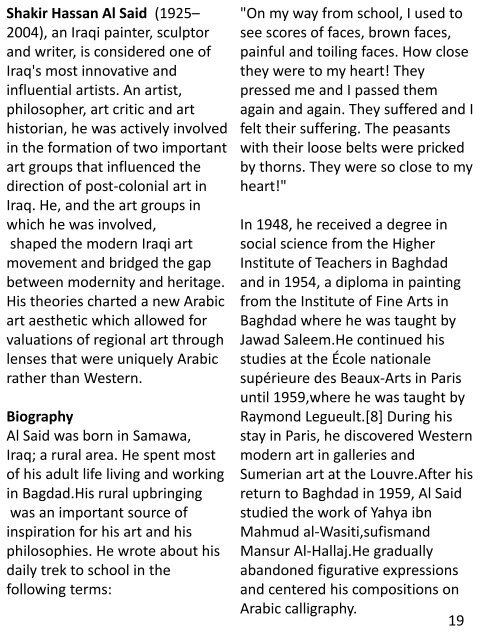Aziz Art August 2018
https://issuu.com/home/docs/aziz_art_august_2018/edit/links
https://issuu.com/home/docs/aziz_art_august_2018/edit/links
You also want an ePaper? Increase the reach of your titles
YUMPU automatically turns print PDFs into web optimized ePapers that Google loves.
Shakir Hassan Al Said (1925–<br />
2004), an Iraqi painter, sculptor<br />
and writer, is considered one of<br />
Iraq's most innovative and<br />
influential artists. An artist,<br />
philosopher, art critic and art<br />
historian, he was actively involved<br />
in the formation of two important<br />
art groups that influenced the<br />
direction of post-colonial art in<br />
Iraq. He, and the art groups in<br />
which he was involved,<br />
shaped the modern Iraqi art<br />
movement and bridged the gap<br />
between modernity and heritage.<br />
His theories charted a new Arabic<br />
art aesthetic which allowed for<br />
valuations of regional art through<br />
lenses that were uniquely Arabic<br />
rather than Western.<br />
Biography<br />
Al Said was born in Samawa,<br />
Iraq; a rural area. He spent most<br />
of his adult life living and working<br />
in Bagdad.His rural upbringing<br />
was an important source of<br />
inspiration for his art and his<br />
philosophies. He wrote about his<br />
daily trek to school in the<br />
following terms:<br />
"On my way from school, I used to<br />
see scores of faces, brown faces,<br />
painful and toiling faces. How close<br />
they were to my heart! They<br />
pressed me and I passed them<br />
again and again. They suffered and I<br />
felt their suffering. The peasants<br />
with their loose belts were pricked<br />
by thorns. They were so close to my<br />
heart!"<br />
In 1948, he received a degree in<br />
social science from the Higher<br />
Institute of Teachers in Baghdad<br />
and in 1954, a diploma in painting<br />
from the Institute of Fine <strong>Art</strong>s in<br />
Baghdad where he was taught by<br />
Jawad Saleem.He continued his<br />
studies at the École nationale<br />
supérieure des Beaux-<strong>Art</strong>s in Paris<br />
until 1959,where he was taught by<br />
Raymond Legueult.[8] During his<br />
stay in Paris, he discovered Western<br />
modern art in galleries and<br />
Sumerian art at the Louvre.After his<br />
return to Baghdad in 1959, Al Said<br />
studied the work of Yahya ibn<br />
Mahmud al-Wasiti,sufismand<br />
Mansur Al-Hallaj.He gradually<br />
abandoned figurative expressions<br />
and centered his compositions on<br />
Arabic calligraphy.<br />
19


















